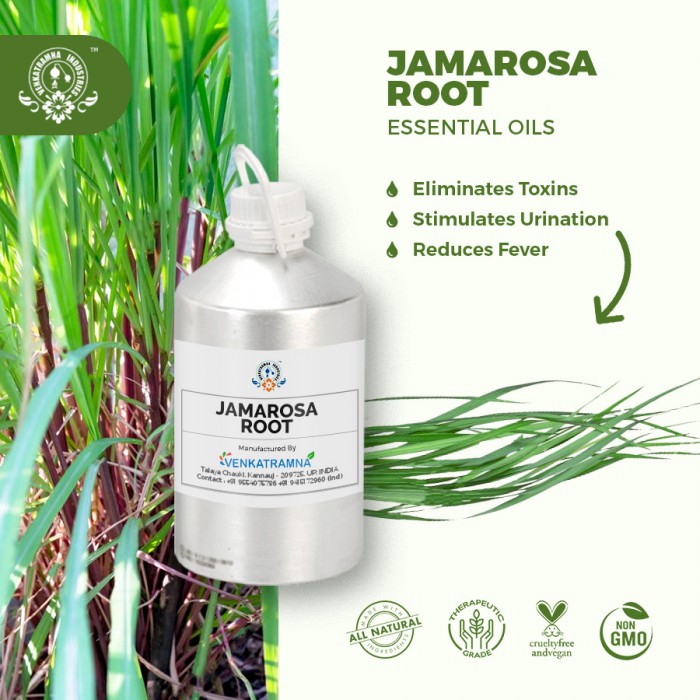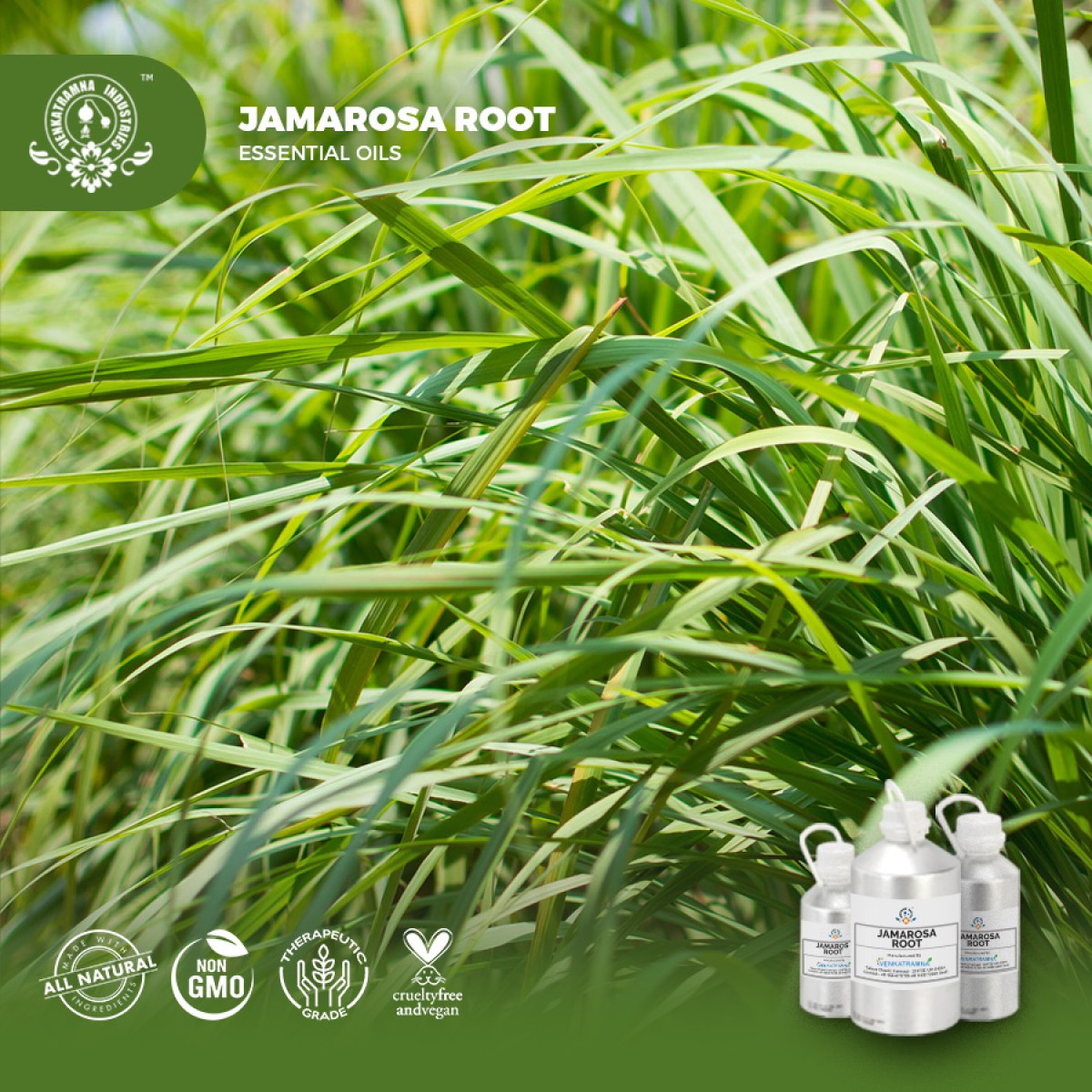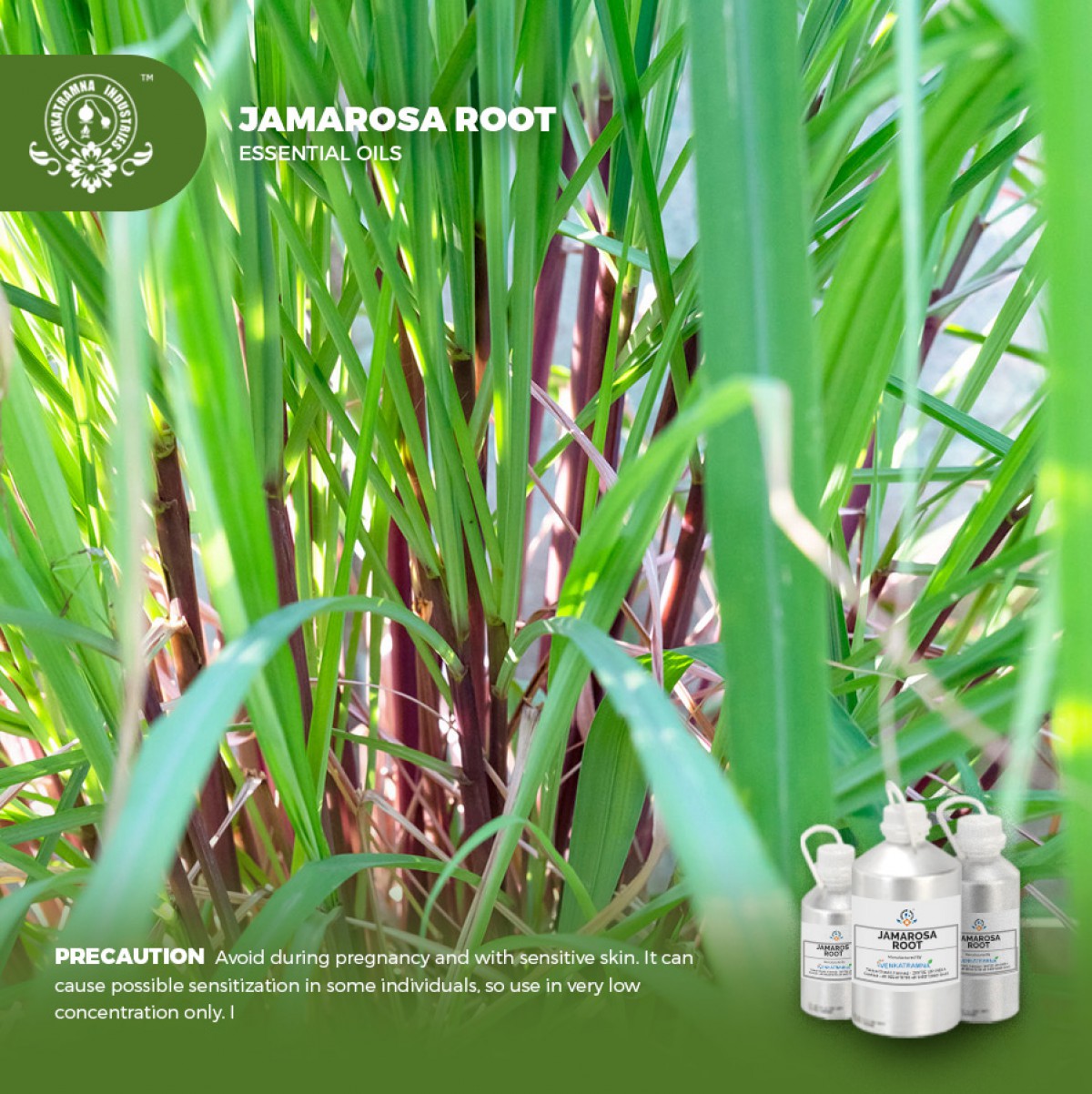Botanical Name: Cymbopogon nardus Common name: Citronella grass, Jamarosa Read More
|
Botanical Name: |
Cymbopogon nardus |
|
Common name: |
Citronella grass,
Jamarosa |
|
Plant family: |
Poaceae |
|
Genus: |
Cymbopogon |
|
Appearance/Color: |
A pale, reddish
yellow liquid of medium consistency with a rosy-grassy odor. |
|
Odor: |
A middle note with a
medium aroma, Jamarosa Root has a rosy, grassy odor with a terpenic note, and
is less sweet and rosy as Palmarosa Oil. |
|
Blends With: |
Palmarosa,
Geranium, Rose Geranium, Ginger grass and Juniper. |
|
Origin: |
India |
|
Source: |
Grass |
|
Method of
Extraction: |
Steam Distillation |
Jamarosa is a grass hybrid of Cymbopogon nardus
var. confertiflorus and Cymbopogon jwarancusa. Jamarosa Root
Essential Oil is most commonly used as a natural fragrance compound when
requiring a rose character. The high quantities of ocimene and geraniol present
in Jamarosa imparts it with the scents of mangoes and roses and this is how it
differs from the palmarosa. Recently, the Jamarosa products have seen a rise in
demand and commercial cultivation of the grass on a larger scale is required.
The Regional Research Laboratory (RRL) in Jammu has developed a new variety of
the Jamarosa which is called CN-5.
Like most of the celebrated herbs, Jamarosa is also
indigenous to the Indian subcontinent and is grown extensively in Southern
India and certain other states including Madhya Pradesh, Chhattisgarh and
Maharashtra.
Jamarosa Root Oil is extracted from the root part of the plant through steam distillation process, it mostly finds usage as a natural fragrance and mainly comprises a blend of geraniol and geranyl acetate.
DISCLAIMER
The complete range of conditions
or methods of use are beyond our control therefore we do not assume any
responsibility and expressly disclaim any liability for any use of this
product. Information contained herein is believed to be true and accurate however,
all statements or suggestions are made without warranty, expressed or implied,
regarding accuracy of the information, the hazards connected with the use of
the material or the results to be obtained from the use thereof. Compliance
with all applicable federal, state, and local laws and local regulations
remains the responsibility of the user.
The FDA has not evaluated the
statements on this website. No claims are made by Venkatramna Industries as to
the medicinal value of any products from vriaroma.com or by us. The information
presented here is for educating our customers about the traditional uses of
essential oils and is not intended to diagnose, treat, cure, or prevent any
disease. You are responsible for understanding the safe application of these products.
If you have any questions, please call or email us for further information.
As per NAHA guidelines, New Directions Aromatics
(NDA) does not recommend the ingestion of essential oils. It is imperative to
consult a medical practitioner before using Essential Oils for therapeutic
purposes. Pregnant and nursing women and those taking prescription drugs are
especially advised not to use this product without the medical advice of a
physician. The oil should always be stored in an area that is inaccessible to
children, especially those under the age of 7.
Jamarosa Essential oil has long tradition
of providing a variety of therapeutic benefits. The use of essential oils in a
cosmetic will have an antiseptic and antimicrobial action, as well as a healing
and soothing effect on the skin. It is useful skin and hair detoxification,
drain, heal and regenerate.
Jamarosa
Root essential Oil in Pharma
Jamarosa Essential Oils are readily absorbed
through the skin, nasal passages and hair follicles and carried to all parts of
the body, having an effect, which can last a few hours to a few days.
Essence of Jamarosa Root essential Oil
Jamarosa Essential
oil is called volatile because most of them are easily vaporized.
It is widely used in perfumery as an alternative to rose.
Excellent in aromatherapy blends when combining a top and a base note. A fresh
uplifting aroma when used in a diffuser. Amazing for skin care and can be
beneficial for those with oily, acne prone skin but also helps to restore
luster to dull skin.
COMMON USAGE
·
Anti-inflammatory Properties
·
Acts as Tonic
·
Removes Bad Odor
·
Eliminates Toxins
·
Stimulates Urination
·
Reduces Fever
·
Inhibits Fungal Growth
·
Prevents Stomach Disorders
·
stimulant
Ingredients:
|
S.No |
Key Constituents |
Strength (%) |
|
1 |
Citronellal |
5.2–46.8 |
|
2 |
Geraniol |
16.8–29.1 |
|
3 |
()-Citronellol |
3.0–21.8 |
|
4 |
(þ)-Limonene |
2.6–11.3 |
|
5 |
(E)-Methyl isoeugenol |
0–10.7 |
|
6 |
Camphene |
0.1–8.0 |
|
7 |
Citronellyl acetate |
0.9–7.3 |
|
8 |
Borneol |
0–6.6 |
|
9 |
Elemol |
1.1–5.0 |
|
10 |
a-Pinene |
1.9–4.8 |
|
11 |
Geranyl formate |
0–4.2 |
|
12 |
b-Cubebene |
0–3.8 |
|
13 |
Geranyl acetate |
2.1–3.4 |
|
14 |
b-Caryophyllene |
0.4–3.2 |
|
15 |
a-Bergamotene |
0–2.3 |
|
16 |
(Z)-b-Ocimene |
0–2.2 |
|
17 |
Isopulegol |
0.5–2.1 |
|
18 |
Guaiene |
0–1.9 |
|
19 |
(E)-b-Ocimene |
0–1.8 |
|
20 |
Methyl eugenol |
0–1.7 |
|
21 |
d-Cadinene |
0.1–1.6 |
|
22 |
Linalool |
0.5–1.5 |
|
23 |
Tricyclene |
0–1.5 |
|
24 |
Geranyl butyrate |
0–1.5 |
|
25 |
a-Cadinene |
0–1.5% |
|
26 |
(Z)-Methyl isoeugenol |
0–1.2 |
TOXICOLOGICAL INFORMATION
Safety Summary
Do not take any oils internally without consultation from a qualified aromatherapy practitioner. Do not apply undiluted essential oils, absolutes or other concentrated essences onto the skin. If you are pregnant, epileptic, have liver damage, have cancer, or have any other medical problem, use oils only under the proper guidance of a qualified aromatherapy practitioner.
Maximum dermal use level (based on methyl eugenol content)
Safety advice
Recommended dermal maximum of 18.2%, based on 29.1% geraniol with a dermal limit of 5.3%. Considering its lack of genotoxicity, its chemo preventive activity, and the fact that anticarcinogens constitute over 60% of the oil while methyl eugenol is only found at 0–1.7%, we do not consider that citronella oil presents a material risk of carcinogenicity.
Regulatory guidelines
Has GRAS status. IFRA recommends a maximum concentration of 0.0004% methyl eugenol in leave-on products such as body lotions (IFRA 2009). The equivalent SCCNFP maximum is 0.0002%. Following a reevaluation of its safety, Canada’s Pest Management Regulatory Agency (PMRA) was unable to conclude that insect repellents containing citronella were acceptable for continued use. The PMRA proposes to phase out citronella-based insect repellents unless data to address uncertainties in their human health risk assessment are generated and submitted by manufacturers. The concerns of the PMRA are that citronella oils may contain methyl eugenol, and that therefore the carcinogenic hazard posed is unacceptable, and that there are no data on reproductive or developmental toxicity.
Organ-specific effects
Systemic effects
ECOLOGICAL INFORMATION





 MSDS-Jamarosa.pdf
MSDS-Jamarosa.pdf




